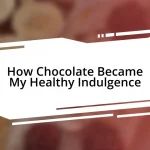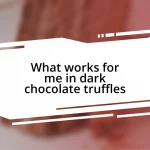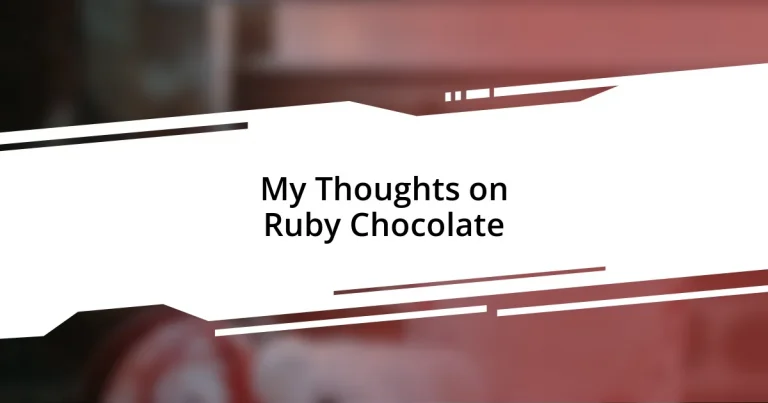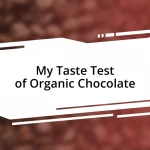Key takeaways:
- Ruby chocolate, introduced in 2017, is made from specially processed cocoa beans, featuring a unique pink hue and a flavor profile that blends fruity and creamy notes.
- Its production involves careful steps including selection of high-quality beans, fermentation for flavor enhancement, and precise processing to achieve its signature taste.
- Ruby chocolate not only adds visual appeal to desserts but also offers health benefits, being rich in antioxidants and potentially supporting heart health.
- This innovative chocolate invites culinary creativity, inspiring bakers to experiment and elevate traditional recipes with its vibrant flavor and color.
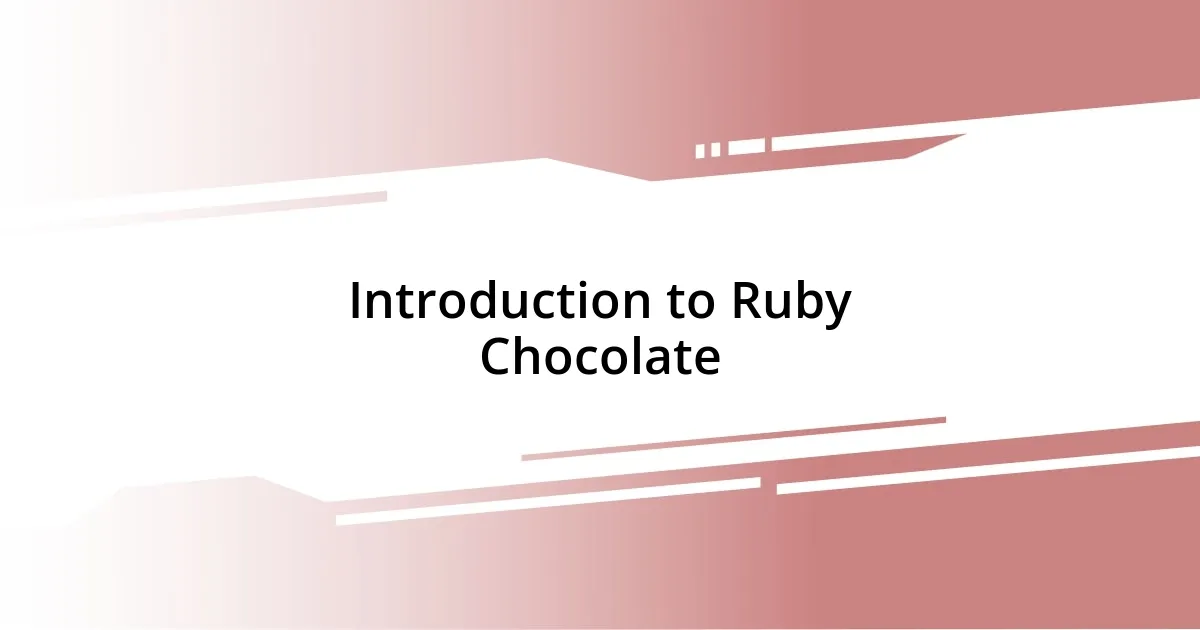
Introduction to Ruby Chocolate
Ruby chocolate, a delightful innovation in the world of confections, first took the stage in 2017. It’s made from specially processed ruby cocoa beans, which gives it that stunning pink hue. I still remember the first time I unwrapped a ruby chocolate bar; its vibrant color immediately sparked my curiosity and excitement.
What truly sets ruby chocolate apart is its unique balance of fruity flavors and creamy texture. Have you ever tasted chocolate that’s both sweet and slightly tart, almost like biting into fresh berries? That’s the magic of ruby chocolate—it brings a refreshing twist to traditional chocolate experiences. Each bite feels like a little celebration, inviting nostalgia for summer days spent enjoying juicy fruits.
When I think about ruby chocolate, I’m struck by how it challenges the conventional spectrum of chocolate. It makes me wonder—can chocolate truly be reinvented? As I’ve explored this captivating flavor, I’ve come to appreciate its ability to provoke conversation and inspire creativity in desserts, making it a fascinating addition to both gourmet and everyday treats.
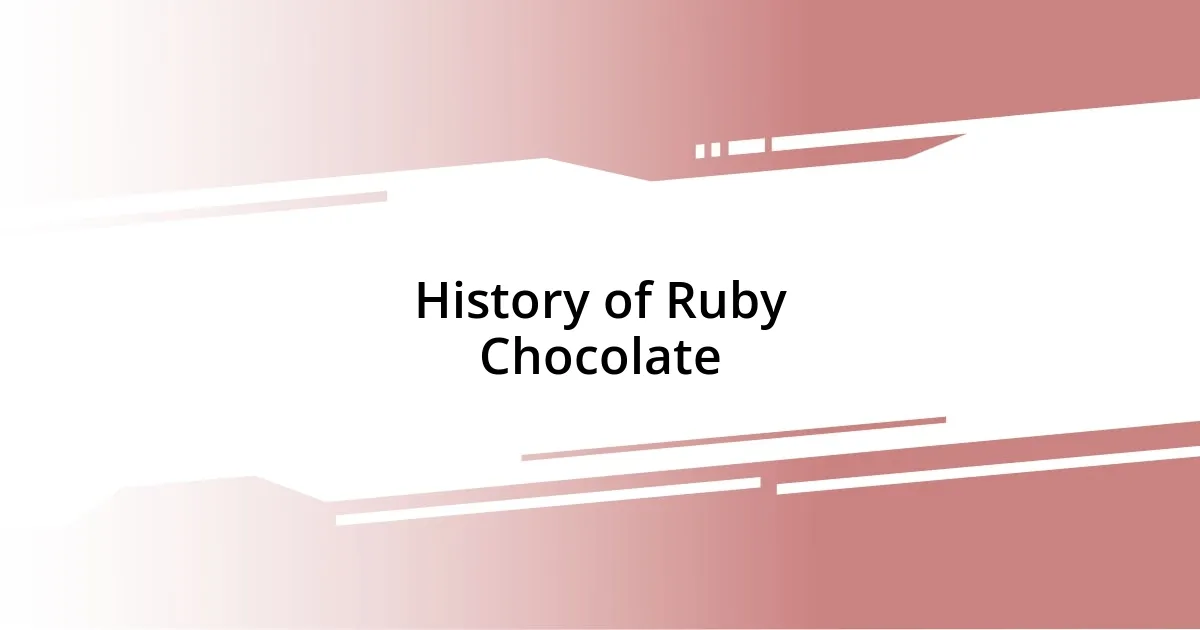
History of Ruby Chocolate
The journey of ruby chocolate is quite fascinating. Originating in 2015, it was unveiled to the world by the famous Belgian chocolatier Callebaut in 2017. I still remember scrolling through social media and seeing stunning photos of ruby chocolate bars pop up everywhere; it was a game-changer that had chocolate lovers everywhere buzzing with excitement.
- Ruby chocolate is derived from specially processed cocoa beans, giving it its signature pink hue.
- Unlike traditional chocolates, ruby chocolate boasts a unique flavor profile that blends fruity and creamy notes.
- The color and taste evoked a sense of novelty; it was like witnessing the dawn of a new chocolate era.
- I can’t help but feel a sense of joy when I see ruby chocolate being used creatively in desserts—from cakes to mousses—it’s exciting to see how it inspires culinary experimentation.
Ruby chocolate has an intriguing backstory that enhances its allure. Its development was a response to the evolving tastes and preferences of chocolate consumers, allowing it to carve out its niche in a traditionally dominated market. When I first tasted it, I was genuinely surprised; it felt like opening a gift on a special occasion, offering something new and unexpected in every bite.
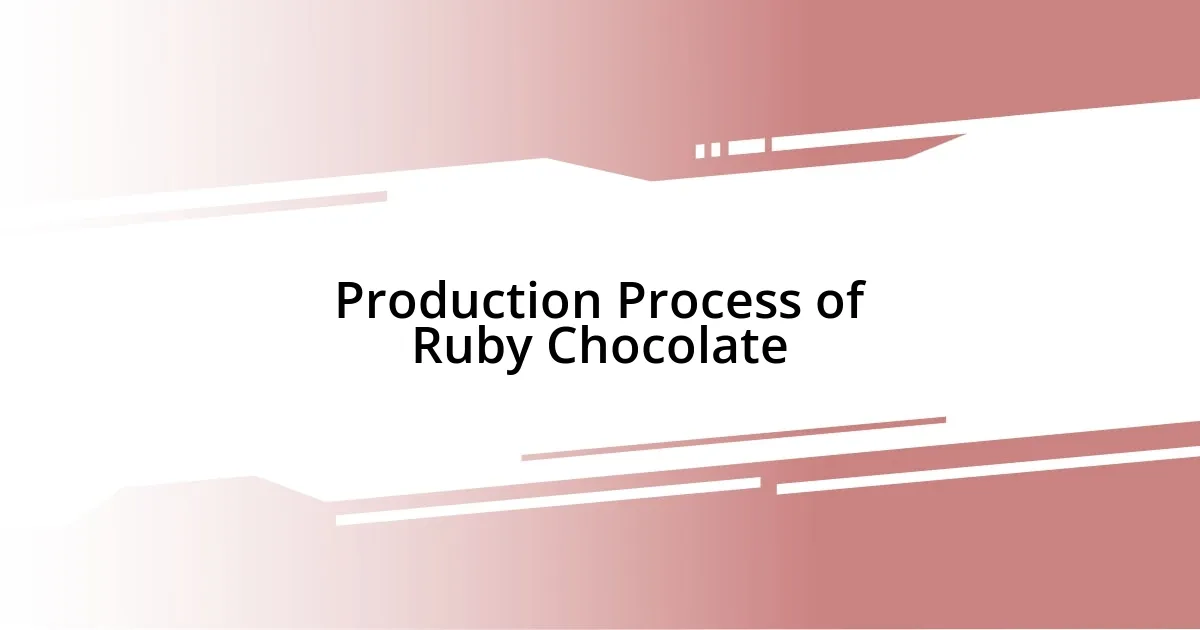
Production Process of Ruby Chocolate
The production process of ruby chocolate is quite fascinating and involves several distinct steps. First, it all starts with the selection of high-quality cocoa beans, which are specially chosen for their unique flavor profiles and vibrant color potential. What’s interesting to me is how these particular beans undergo fermentation—a critical stage that enhances their flavors and helps develop that beloved pink hue. I remember experimenting with chocolate-making at home, and seeing how fermentation can transform simple ingredients into something extraordinary truly sparked my love for the craft.
Once the beans are harvested, they are meticulously processed to maintain their vibrant color. This involves roasting, winnowing, and grinding the beans to extract cocoa mass. The process can be quite precise, with skilled chocolatiers ensuring the perfect balance of fruity and creamy notes. I think of it like crafting a fine wine; each tiny detail matters immensely in achieving the final product. I often find myself getting lost in the details, understanding how each step contributes to the overall flavor and texture.
Finally, the magic happens with the addition of sugar and milk. This blend creates ruby chocolate’s signature taste and texture, inviting you into an experience that feels both luxurious and playful. Every time I bite into a piece of ruby chocolate, I am reminded of how craftsmanship is intertwined with passion and creativity in chocolate-making. It’s a celebration of flavor that I believe everyone should experience at least once!
| Step | Description |
|---|---|
| Selection of Cocoa Beans | High-quality beans are chosen for their flavor profiles and potential color. |
| Fermentation | A crucial stage that enhances flavors and develops the pink hue. |
| Processing | Involves roasting, winnowing, and grinding to extract cocoa mass. |
| Blending | Addition of sugar and milk to achieve the final ruby chocolate flavor and texture. |
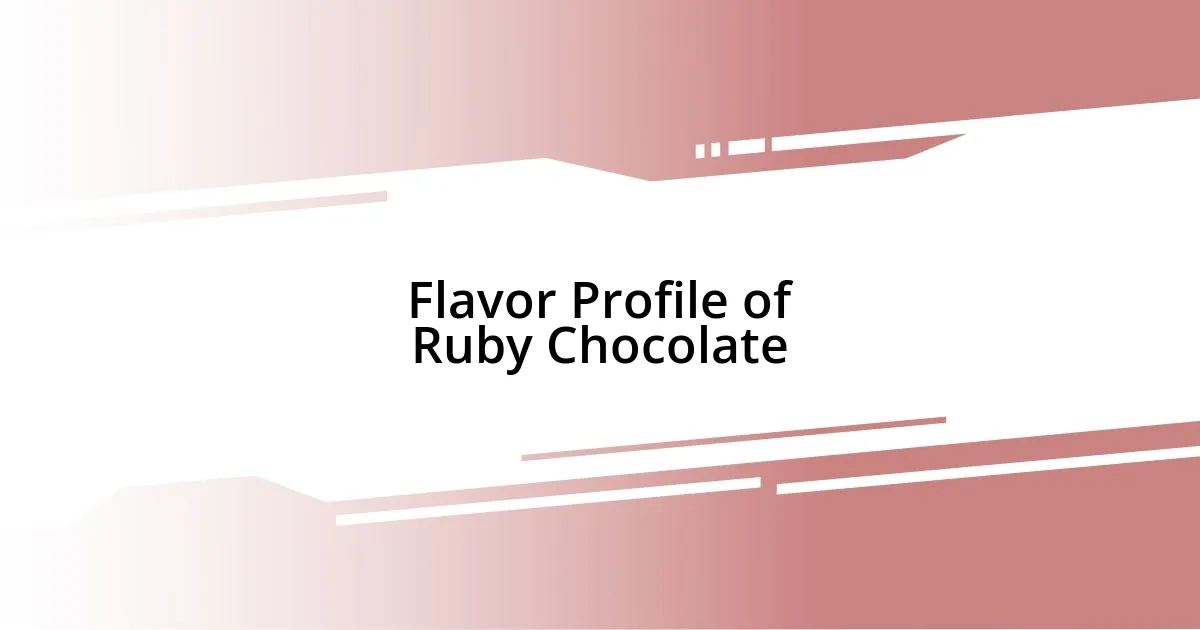
Flavor Profile of Ruby Chocolate
The flavor profile of ruby chocolate is a delightful adventure for the palate. I often find myself captivated by its unique combination of fruity and creamy notes, which together create a taste that feels simultaneously familiar yet refreshingly new. Every bite reminds me of a summer berry medley, with a hint of creaminess that gives it a smooth finish—almost like dessert and fruit salad had a joyful reunion.
What really strikes me is that ruby chocolate carries a sophisticated sweetness, unlike the traditional milk or dark varieties. It evokes emotions of nostalgia and whimsy, transporting me back to my childhood summers when I’d indulge in fruit-flavored sweets. Have you ever experienced a flavor that made you smile? For me, ruby chocolate does just that—it’s sweet without being cloying, making it an ideal treat for those sunny days when you crave something light yet indulgent.
As I savor ruby chocolate, I often notice how it enhances desserts, adding a pop of color and a burst of flavor. I’ll never forget the first time I tried a ruby chocolate mousse; it was a culinary revelation. The layers of flavor danced on my tongue, making me wonder how such a captivating profile wasn’t in the spotlight sooner. Ruby chocolate invites creativity in desserts, allowing bakers and chefs to experiment beyond the usual chocolate offerings, which I find absolutely thrilling. The possibilities are endless!

Uses in Desserts and Recipes
Ruby chocolate has quickly become a favorite ingredient in my dessert repertoire. One of my go-to recipes is ruby chocolate ganache, which transforms the classic chocolate ganache into something visually striking and deliciously unique. The first time I drizzled it over a simple cheesecake, I was utterly charmed by the way it added both a pop of color and a burst of flavor—many guests asked for the recipe that evening.
Another delightful application is in baking ruby chocolate cookies. The rich flavor contrasts beautifully with a sprinkle of sea salt, enhancing each bite, and I often find myself reaching for a warm cookie fresh from the oven. When I made these for a friend’s birthday, watching their eyes light up as they took the first bite reminded me how special it is to share homemade treats. It’s moments like these that make dessert preparation an expression of love and creativity.
Moreover, I love using ruby chocolate in celebrating special occasions. Picture a layered ruby chocolate cake with fresh berries—a delightful combination that not only satisfies the palate but also adds a festive touch to any gathering. I remember how I felt crafting that cake for my sister’s graduation; it was as if each layer was infused with my excitement for her achievements. The visual appeal of ruby chocolate can truly elevate any dessert, making it an exciting choice for those looking to impress. Why settle for ordinary when you can create something extraordinary?
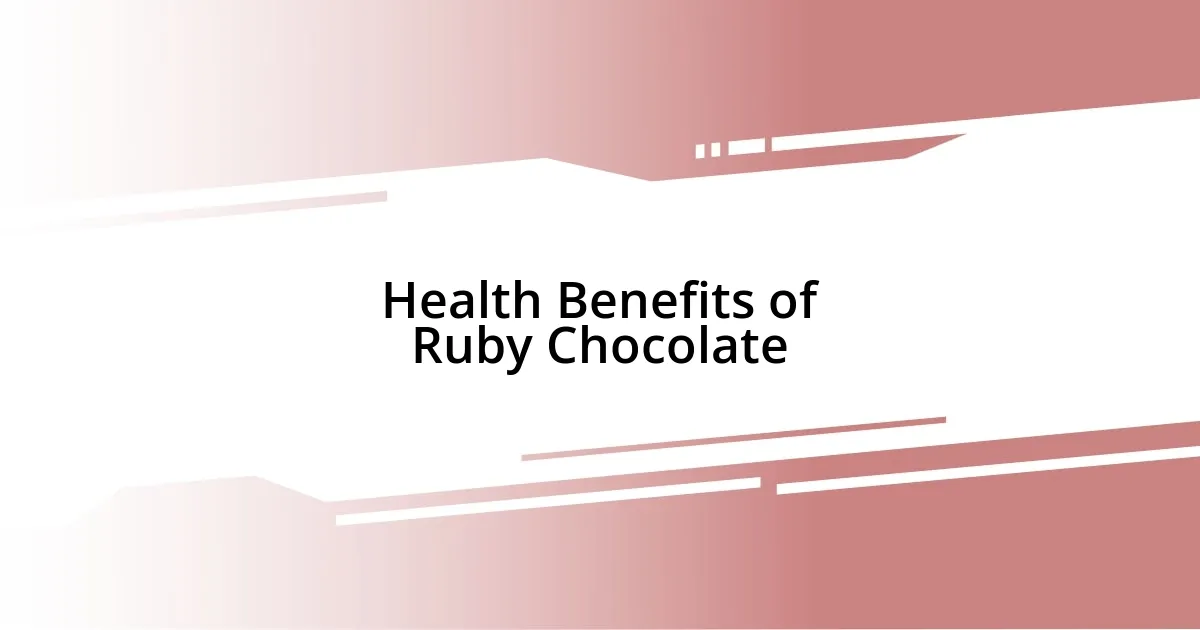
Health Benefits of Ruby Chocolate
Ruby chocolate isn’t just a feast for the senses; it also offers some surprising health benefits that I find fascinating. This delightful treat is rich in antioxidants, which help combat oxidative stress in our bodies. When I first learned about the benefits of antioxidants, it struck me how something so indulgent could actually contribute to overall well-being. Who wouldn’t want a little sweet treat that offers a boost to their health?
Another aspect I cherish about ruby chocolate is its potential cardiovascular benefits. It contains flavonoids, compounds known to support heart health by improving circulation and possibly lowering blood pressure. I remember feeling somewhat guilty when I indulged in dessert, but now I can enjoy a piece of ruby chocolate, knowing it’s not just a guilty pleasure—it’s a little bit of heart-smart goodness! Isn’t it reassuring to find joy in something that also does something good for you?
Furthermore, ruby chocolate can enhance mood thanks to its cocoa content, which may stimulate the production of endorphins. I often turn to chocolate when I need a little pick-me-up, and ruby chocolate has become my go-to. Have you ever noticed how a small piece of chocolate can brighten your day? I certainly have, especially after a long week; a few bites of ruby chocolate feel like a wholesome reward that wraps me in comfort and joy.







